

WorkWORLD
 |
 |
||||
| Get Latest WorkWORLD |
|||||
|
|
www.workworld.org |
workworld@vcu.edu |
NOTE: This topic describes details about how to use the Import Tool available in WorkWORLD. See the "Import a Case File - Overview" topic for an overview of the import process, which you should read first.
Importing one or more case files is an easy process in WorkWORLD. This topic first includes the procedural steps required to import a case, and then provides a detailed explanation of the process.
You can jump directly to these sections by clicking on their names above. If you are unfamiliar with the process, you can read each section in the order presented to learn how to import case files from WorkWORLD.
REMEMBER: External case files use the same name they had within WorkWORLD, and always have a .ECF extension. By default, they are located in the "External Case Files" sub-folder of the WorkWORLD program folder.
The essential steps required to import case files are listed below. In each step there is a hypertext link that can provide detailed information about that step.
1. Start the Import process by choosing Tools on the Main Menu, and then Import on the drop-down menu.
2. Decide where to read the files from by accepting the default, or Browse to a different folder to find the external case files.
3. Select the cases to import from the File Import window.
4. Begin to import files by using the Import button.
5. Close the Import window by using the Cancel button.
You can import case files at any time from within WorkWORLD. If you are in the middle of entering a new case, you should first save it normally to avoid potential problems. It is best to import cases when no existing files are open within WorkWORLD.
To start an import procedure, click "Tools" on the WorkWORLD Main Menu, then "Import…" on the drop-down menu:
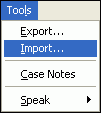
Alternatively, from the keyboard, you can hold the "Alt" key down while you type "L", then type "I":
![]() +
+ ![]() ,
, ![]()
This will cause the File Import window to appear:
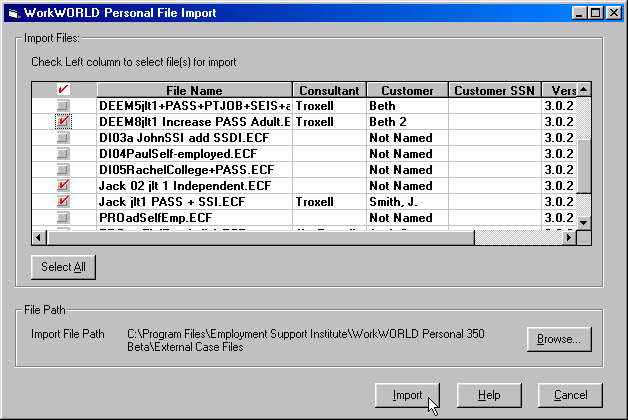
The File Import window shows the complete Import File Path just below the grid. You can decide to accept the default destination folder "External Case Files" as the location of your external case files, or change it to some other existing folder.
The Browse button, located to the right of the Import File Path name, allows you to choose a different folder as the location of the external case files. You can click on it with a mouse or hold down the "Alt" key while typing "B" on your keyboard. This will bring up the Folder Selection window:
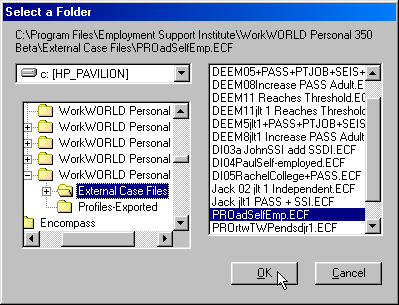
The complete Import File Path is shown as a name across the very top of this window. The path is also shown graphically in a folder pane in the middle left of the window. The drive is shown in a small pane just above the folder pane. On the upper right side of the window there is a pane which shows files contained in the selected folder.
To change to a different folder, first select the drive. Click the down arrow button on the right side of the drive pane to drop down a list of available drives on your computer. Then highlight your choice and click on it. It will then be displayed in the drive pane.
After the correct drive is shown in the drive pane, a list of first-level folders will be shown in the folder pane. You can highlight and double-click on the folder names to reveal subfolders contained within them. As you do so, any files contained within the folder you click on will be displayed in the files pane on the right side of the window.
Finally, click the OK button on the Folder Selection window to accept your selection and return to the File Import window.
The File Import window shows you, among other things, a list of all your external case files in the form of a grid. The grid includes, if necessary, scroll bars on the right and/or bottom sides to shift what the grid displays up and down or left and right. You can use the scroll bars with a mouse by clicking on the arrows at the bar ends. Or from your keyboard, use the up, down, right, and left arrow keys to control the scroll bars.
The grid contains one row for each external case file saved in the directory you chose above. Starting at the left, the grid displays in six columns a check box (see below), the file name, consultant name, customer name, customer SSN, and file version for each case.
NOTE: You can sort on any of the columns to make it easier for you to find or keep track of the cases listed. To sort, simply click on one of the column headings. Each time you click, you toggle the direction of the sort from ascending to descending. For instance, the first click on the File Name heading will list all your cases alphabetically from A to Z. If you click the heading again, the cases will be listed from Z to A. If you sort on the Check column, all the cases you selected will be grouped together at the top (or bottom) of the list.
The first column of the grid contains a check box on each row of the grid. This allows you to select one or more of the cases for import. You can use your mouse to make a selection by pointing to the appropriate check button and clicking on it. From the keyboard, first use the tab key to bring focus to the check boxes. Then use the arrow keys to move the bold selection box over the cell containing the appropriate check box and hit the space bar to select:
![]() ,
, ![]()
![]() ,
, ![]()
The check boxes are toggled by the actions described above. That is, the first time you click on a box, you select it and a red check mark will appear as confirmation. When you click again on the same box, you deselect it and the check mark disappears. The toggle behavior is the same whether you are using the mouse or keyboard method of selection.
If you want to select all the case files listed in the grid, you can click the Select All button that is located on the left side of the File Import window, just below the grid. From your keyboard, you can do this by holding down the "Alt" key while you type "A". Note that once you use the Select All button, its function changes to Clear All, which allows you to deselect all the case files. When you want to import most (but not all) of your external case files, a quick way to do this is to first use Select All and then deselect the cases you don't want to export.
However you select them, each external case file with a red checkmark in its checkbox will be read in and saved as an individual case in the internal WorkWORLD database later.
When the correct folder is shown in the Import File Path and you have selected the desired external case files, you are ready to begin exporting the files you previously selected.
Click the Import button on the bottom of the File Import window to begin. You can also hold down the "Alt" key and type "I" to do the same thing.
If you try to begin importing before you select any files, an error message will notify you:
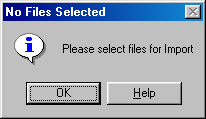
Selecting the "Help" button will pop up the "Import a Case File - No Files Selected" Help topic, and provide you further information about selecting files prior to attempting export. The "OK" button will return you to the File Import window.
The file import process may take some time to complete, depending on how many files you are importing and the speed of your computer. During the import process, the Windows hourglass and a progress indicator display:
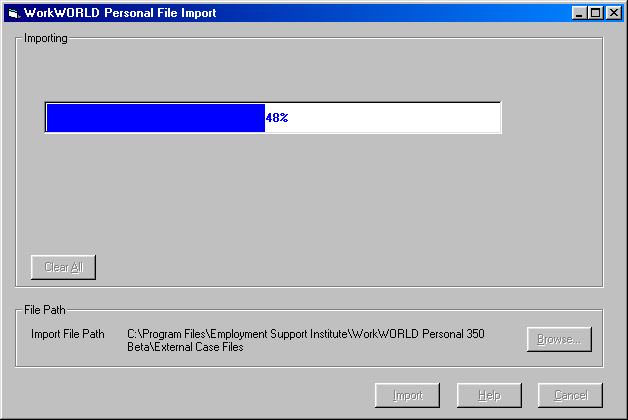
Imported files are given the same name as they had within the originating copy of WorkWORLD. If a file already exists in the internal WorkWORLD database with the same name as one of the imported files, the file name of the imported file is appended with a "dup" number. A message window will notify you:

Selecting the "Help" button will pop up the "Import a File - Duplicate Import File Name" Help topic, yielding further information about duplicated and renamed import files. Selecting the "OK" button will return you to the File Import window.
When all the files you selected have been converted into cases, a small message window pops up to notify you:
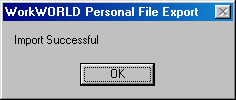
Click the OK button or hit the Enter key to acknowledge.
Finally, you can end the process and return to the WorkWORLD main screen by clicking the Cancel button on the bottom right of the File Import window. From the keyboard, you can hold down the Alt key and type C. Another way to close the File Export window is to click the Windows "X" close button on the upper right corner of the File Export window:
![]()
WorkWORLD™ Help/Information System
![]() Share/Save: Click the button or link at left to select your favorite bookmark service and add this page.
Share/Save: Click the button or link at left to select your favorite bookmark service and add this page.
This is one topic from the thousands available in the WorkWORLD™ software Help/Information System.
Complete information about the software is available at: http://www.WorkWORLD.org
See How to Get WorkWORLD page at: http://www.WorkWORLD.org/howtogetWW.html
NOTE: Sponsored links and commercial advertisements help make the WorkWORLD™ website possible by partially defraying its operating and maintenance expenses. No endorsement of these or any related commercial products or services is intended or implied by the Employment Support Institute or any of its partners. ESI and its partners take no responsibility for, and exercise no control over, any of these advertisements or their views or contents, and do not vouch for the accuracy of the information contained in them. Readers are cautioned to verify all information obtained from these advertisements prior to taking any actions based upon them. The installed WorkWORLD software does not contain advertisements of any kind.
Copyright © 1996, 1997, 1998, 1999, 2000, 2001, 2002, 2003, 2004, 2005, 2006, 2007, 2008, 2009, 2010, 2011, 2012, Virginia Commonwealth University. All rights reserved.